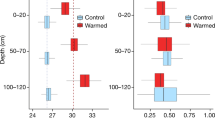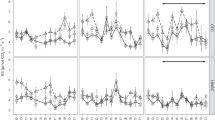Abstract
In the Northern Hemisphere, ozone levels in the troposphere have increased by 35 per cent over the past century1, with detrimental impacts on forest2,3 and agricultural4 productivity, even when forest productivity has been stimulated by increased carbon dioxide levels5. In addition to reducing productivity, increased tropospheric ozone levels could alter terrestrial carbon cycling by lowering the quantity and quality of carbon inputs to soils. However, the influence of elevated ozone levels on soil carbon formation and decomposition are unknown. Here we examine the effects of elevated ozone levels on the formation rates of total and decay-resistant acid-insoluble soil carbon under conditions of elevated carbon dioxide levels in experimental aspen (Populus tremuloides) stands and mixed aspen–birch (Betula papyrifera) stands. With ambient concentrations of ozone and carbon dioxide both raised by 50 per cent, we find that the formation rates of total and acid-insoluble soil carbon are reduced by 50 per cent relative to the amounts entering the soil when the forests were exposed to increased carbon dioxide alone. Our results suggest that, in a world with elevated atmospheric carbon dioxide concentrations, global-scale reductions in plant productivity due to elevated ozone levels will also lower soil carbon formation rates significantly.
This is a preview of subscription content, access via your institution
Access options
Subscribe to this journal
Receive 51 print issues and online access
$199.00 per year
only $3.90 per issue
Buy this article
- Purchase on SpringerLink
- Instant access to full article PDF
Prices may be subject to local taxes which are calculated during checkout


Similar content being viewed by others
References
IPCC Climate Change 2001: Technical Summary (Report of the Intergovernmental Panel on Climate Change, IPCC Secretariat, Geneva, 2001).
Gregg, J. W., Jones, C. G. & Dawson, T. E. Urbanization effects on tree growth in the vicinity of New York City. Nature 424, 183–187 (2003)
McLaughlin, S. B. & Downing, D. J. Interactive effects of ambient ozone and climate measured on growth of mature forest trees. Nature 374, 252–254 (1995)
Chameides, W. L., Kasibhatla, P. S., Yienger, J. & Levy, H. I. Growth of continental-scale metro-agro-plexes, regional ozone pollution, and world food production. Science 264, 74–77 (1994)
Percy, K. E. et al. Altered performance of forest pests under CO2- and O3-enriched atmospheres. Nature 420, 403–407 (2002)
Latest Findings on National Air Quality: 2002 Status and Trends (US Environmental Protection Agency).
Findlay, S., Carreiro, M., Krischik, V. & Jones, C. G. Effects of damage to living plants on leaf litter quality. Ecol. Appl. 6, 269–275 (1996)
Coleman, M. D., Dickson, R. E., Isebrands, J. G. & Karnosky, D. F. Carbon allocation and partitioning in aspen clones varying in sensitivity to tropospheric ozone. Tree Physiol. 15, 593–604 (1995)
Andersen, C. P. Source-sink balance and carbon allocation below ground in plants exposed to ozone. New Phytol. 157, 213–228 (2003)
King, J. S. et al. Fine-root biomass and fluxes of soil carbon in young stands of paper birch and trembling aspen as affected by elevated atmospheric CO2 and tropospheric O3 . Oecologia 128, 237–250 (2001)
Dickson, R. E. et al. Forest Atmosphere Carbon Transfer and Storage (FACTS-II)—The Aspen Free-air CO2 and O3 Enrichment (FACE) Project: An Overview (Technical Report NC-214, USDA, Washington DC, 2000)
Leavitt, S. W., Follett, R. F. & Paul, E. A. Estimation of slow- and fast-cycling soil organic carbon pools from 6N HCl hydrolysis. Radiocarbon 38, 231–239 (1996)
Paul, E. A. et al. Radiocarbon dating for determination of soil organic matter pool sizes and dynamics. Soil Sci. Soc. Am. J. 61, 1058–1067 (1997)
Phillips, R., Zak, D. R., Holmes, W. E. & White, D. C. Microbial community composition and function beneath temperate trees exposed to elevated atmospheric carbon dioxide and ozone. Oecologia 131, 236–244 (2002)
Larson, J., Zak, D. R. & Sinsabaugh, R. L. Extracellular enzyme activity beneath temperate trees growing under elevated carbon dioxide and ozone. Soil Sci. Soc. Am. J. 66, 1848–1856 (2002)
Acknowledgements
This research was supported by the US Department of Energy's Office of Science (BER: Program for Ecosystem Research and National Institute for Global Environmental Change), the USDA Forest Service (Northern Global Change and North Central Research Station), the National Science Foundation (DEB, DBI/MRI), and the USDA Natural Research Initiatives Competitive Grants Program. G. Hendry, K. Lewin, J. Nagey, D. Karnosky and J. Sober have been instrumental in the successful implementation of this long-term field experiment.
Author information
Authors and Affiliations
Corresponding author
Ethics declarations
Competing interests
The authors declare that they have no competing financial interests.
Rights and permissions
About this article
Cite this article
Loya, W., Pregitzer, K., Karberg, N. et al. Reduction of soil carbon formation by tropospheric ozone under increased carbon dioxide levels. Nature 425, 705–707 (2003). https://doi.org/10.1038/nature02047
Received:
Accepted:
Issue Date:
DOI: https://doi.org/10.1038/nature02047
This article is cited by
-
Urban–rural gradients in soil nutrients beneath Chinese pine (Pinus tabulaeformis Carr.) are affected by land-use
Urban Ecosystems (2022)
-
Elevated ozone increases nitrifying and denitrifying enzyme activities in the rhizosphere of wheat after 5 years of fumigation
Plant and Soil (2015)
-
Threat to future global food security from climate change and ozone air pollution
Nature Climate Change (2014)
-
Soil microbial residue dynamics after 3-year elevated O3 exposure are plant species-specific
Plant and Soil (2014)
-
Adapting agriculture to climate change: a review
Theoretical and Applied Climatology (2013)
Comments
By submitting a comment you agree to abide by our Terms and Community Guidelines. If you find something abusive or that does not comply with our terms or guidelines please flag it as inappropriate.



